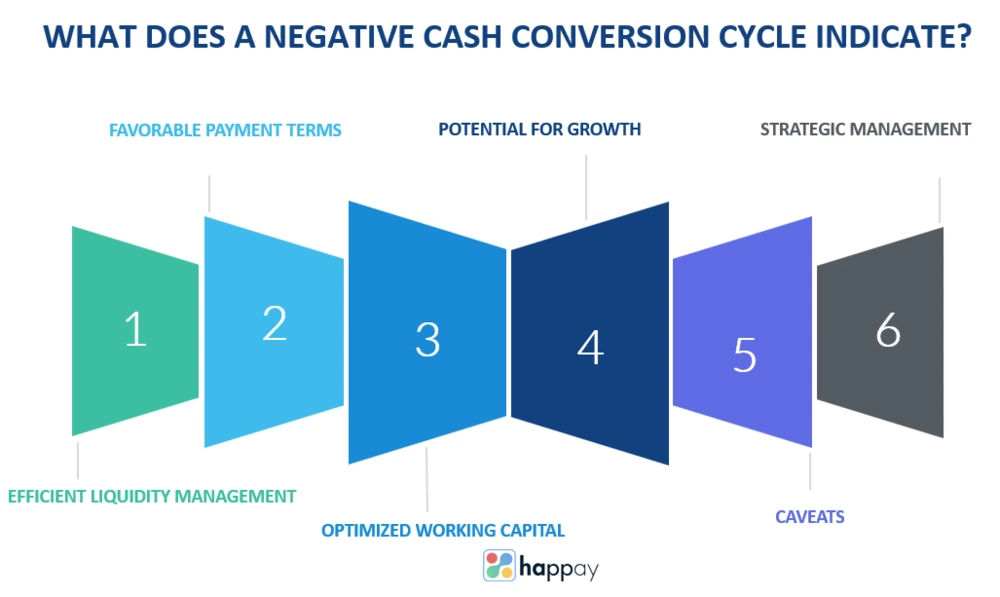Last Updated on November 28, 2025
Introduction
Looking to get a comprehensive view of your company’s operational efficiency and liquidity management? Look no further than the cash conversion cycle (CCC), a crucial metric within financial management. The CCC represents the time it takes for a business to convert its resources, like inventory and raw materials, into cash flow. Generating cash flow happens through sales and subsequent payments from customers.
The metric showcases a delicate balance between the company’s ability to maintain adequate inventory levels while expeditiously converting sales into cash. However, the management of the cash conversion cycle is often intricate. It requires attention to detail and a strategic approach to mitigate potential challenges.
This article assesses the intricacies of the cash conversion cycle, highlighting its predicaments. We will also look at solutions to enhance your business’s operational efficacy and financial health.
Quick Read: 10 Best Financial Management Tools
What is the cash conversion cycle (CCC)?
CCC is a fundamental financial metric gauging the efficiency with which a company manages its working capital components. These include inventory, accounts receivable, accounts payable, etc. Furthermore, the metric represents the time a business requires to convert its invested resources into cash inflows.
To understand the cash conversion cycle meaning, with an example, let’s consider a manufacturing company that produces and sells electronic gadgets. The CCC for this company would look like this:
- Procurement of raw materials to manufacture the devices (accounts payable)
- Production process
- Storage of finished goods (days of inventory)
- Sale of the devices to customers (accounts receivable)
- Collection of payment.
The CCC is the amount of time taken for each of these stages. A shorter figure means the company is efficiently turning its investments into cash, while a longer one may indicate inefficiencies in operations and total credit sales management.
Read About: 10 Best Accounts Payable (AP) Software
What is the importance of the cash conversion cycle?
Here are some reasons why CCC holds significance in your organization’s financial management.
1. Working capital optimization
The CCC helps optimize working capital utilization by reducing the time it takes to convert invested resources into cash. The efficient conversion enhances cash flow predictability and reduces the risk of cash shortages for smoother operations.
2. Timely financial obligations
Efficient Cash Conversion Cycle management enables a company to meet its financial obligations promptly. Converting resources into cash quicker allows you to pay suppliers and creditors on time. The result is positive relationships and potentially favorable terms and discounts.
3. Internal performance assessment
Analyzing different operating cycle stages, like the accounts receivable collection period, helps pinpoint inefficiencies. It will allow you to take targeted actions to streamline operations and reduce costs.
4. Operational streamlining
A well-maintained CCC facilitates operational streamlining as it encourages a balanced approach to inventory management. You can prevent excess inventory levels that tie up resources and incur storage costs. Similarly, efficient collection of accounts receivable ensures a steady cash inflow for effective resource allocation.
5. Investor and creditor confidence
Investors and creditors often scrutinize the CCC during due diligence. A favorable number indicates effective working capital management and a robust operational foundation. Conversely, an unfavorable Cash Conversion Cycle might raise concerns about resource management efficiency. It can affect your company’s creditworthiness and attractiveness to investors.
6. Strategic decision-making
The CCC provides valuable insights for strategic decision-making by monitoring the cycle. You can adapt your credit policies and inventory levels to changing market conditions or customer behavior. It will help maintain agility and competitiveness.
7. Financial health indicator
A shorter CCC suggests strong liquidity management and efficient resource utilization. On the other hand, a longer cycle might indicate operational inefficiencies you must address to improve financial performance.
8. Cash flow stability
Effective working capital management ensures a company has the funds to cover operational expenses and growth initiatives. Furthermore, it reduces the reliance on external financing.
Also, Read: 8 Best Inventory Management Software
Analyzing and understanding the cash conversion cycle
Let’s look at the critical aspects of understanding the CCC.
1. Interpreting the CCC
A shorter CCC indicates a more efficient conversion of resources into cash, which is generally favorable. However, the interpretation of the values can vary based on industry norms and business models. Comparing these numbers with industry benchmarks helps contextualize its performance and identify whether its cycle aligns with industry standards.
2. Implications of CCC Trends
Tracking CCC trends over time is crucial. A decreasing figure signifies that the company is becoming more efficient in its operations. It could be due to improved inventory management or elongated supplier payment terms. Conversely, an increasing number might signal operational bottlenecks and potential liquidity issues. You may need to revisit your credit and payment policies.
3. Working capital management
The CCC is pivotal in working capital management as it offers insights into how effectively a company utilizes its capital to support daily operations and growth initiatives. An optimized number ensures a balance between efficient resource utilization and maintaining adequate liquidity for unforeseen circumstances.
4. Operational efficiency
A comprehensive understanding of the CCC helps identify areas of operational inefficiency. For example, a prolonged days inventory outstanding (explained below) might point to excess inventory. It can lead to increased costs to store stock. A protracted days sales outstanding (explained below) might highlight issues with credit policies or customer payment behavior.
5. Strategies for improvement
Analyzing the CCC helps you devise strategies to enhance operational efficiency. Shortening the DIO could involve adopting lean inventory management practices. On the other hand, reducing the DSO might involve improving credit assessment procedures or offering discounts for early payments. You can prolong the outstanding days payable (explained below) by effectively negotiating with suppliers or optimizing payment schedules.
Must Read: Cash Flow Forecasting: What is it, Components, Methods, Process & Formats
Components of the cash conversion cycle
The CCC consists of the following three components that highlight the working capital efficiency of your organization. Understanding these components is essential for a comprehensive grasp of the CCC’s impact on operational effectiveness and financial health.

1. Days Inventory Outstanding (DIO)
The DIO measures the average number of days a company takes to convert its inventory into sales. A lower DIO suggests that stock moves swiftly through sales, indicating effective inventory management and potential cost savings. Conversely, more days could indicate excessive inventory levels that can tie up resources and increase storage costs. Analyzing this number helps optimize inventory levels and align them with actual demand.
2. Days Sales Outstanding (DSO)
The DSO reflects the company’s average days to collect customer payments after a sale. A shorter DSO indicates efficient credit management and timely collection of accounts receivable, enhancing cash flow. A higher number of days might point to issues with credit policies and customer payment habits. Monitoring this number helps you adopt strategies to accelerate payment collection. For example, you can offer incentives for early payments or refine credit assessment procedures.
3. Days Payable Outstanding (DPO)
The DPO is the average number of days a company takes to pay its suppliers after receiving inventory. A longer DPO can positively impact cash flow, providing a longer window to use resources before settling payments. However, excessively extending payment terms could strain supplier relationships and result in missed discounts. Balancing the DPO with maintaining strong supplier relationships is vital to optimizing cash flow without compromising strategic partnerships.
Read More: Cash Flow Statements: A Comprehensive Guide
Cash conversion cycle formula
The CCC formula considers inventory turnover, accounts receivable collection, and accounts payable payment periods. The formula is as follows.

Where:
- DIO (Days Inventory Outstanding): Average days for inventory to be converted into sales.
- DSO (Days Sales Outstanding): Average days to collect customer payments after a sale.
- DPO (Days Payable Outstanding): Average days to pay suppliers after receiving inventory.
Here’s an example to expand further on the cash conversion cycle formula:
Company XYZ’s Scenario:
DIO (Days Inventory Outstanding) = 40 days
DSO (Days Sales Outstanding) = 30 days
DPO (Days Payable Outstanding) = 60 days
Calculation:
CCC = DIO + DSO – DPO
= 40 days + 30 days – 60 days
= 10 days
In this example, Company XYZ’s cash conversion cycle is ten days. It takes the company ten days to convert its invested resources into cash flows, considering the average delay in paying its suppliers.
If the figure is positive, as in this case, it indicates that Company XYZ’s operational cycle requires a shorter time to convert resources into cash than it takes to settle its payables. It suggests favorable liquidity management and the ability to cover obligations without relying heavily on short-term financing.
A shorter cycle could result from efficient inventory turnover and prompt collections for Company XYZ. However, they might also explore opportunities to optimize the DPO by negotiating more favorable payment terms with suppliers.
Suggested Read: Order to Cash (O2C) Process: A Step-by-Step Approach
How to calculate the cash conversion cycle
Here is a guide to calculating the cash conversion cycle:
1. Determine component values
- DIO
Calculate the average days for converting inventory into sales. You can do it using the formula: DIO = (Average Inventory / Cost of Goods Sold) * 365.
- DSO
Calculate the average days it takes to collect customer payments after a sale. Use the formula: DSO = (Accounts Receivable / Net Sales) * 365.
- DPO
Calculate the average days it takes to pay suppliers after receiving inventory. Employ the formula: DPO = (Accounts Payable / Cost of Goods Sold) * 365.
2. Add values into the CCC formula
Once you have determined the values for DIO, DSO, and DPO, add them to the formula:
CCC = DIO + DSO – DPO.
3. Interpretation and analysis
A positive number indicates that the company’s operational cycle is shorter than it takes to settle payables, which generally reflects effective liquidity management. A negative figure suggests that the company is settling payables before collecting cash from sales. It might indicate aggressive payment terms or efficient cash flow management.
4. Illustrative example
Let’s consider a hypothetical scenario for Company ABC:
DIO = 40 days
DSO = 30 days
DPO = 50 days
Calculation:
CCC = DIO + DSO – DPO
= 40 days + 30 days – 50 days
= 20 days
5. Interpretation
In this example, Company ABC’s CCC is 20 days, signifying that, on average, it takes 20 days to convert invested resources into cash flows. It also accounts for the length of time it takes to settle payables. It indicates efficient liquidity management and the ability to cover obligations within a favorable timeframe.
6. Strategic implications
A shorter number suggests efficient inventory turnover, prompt collections, and an opportunity to extend payment terms with suppliers. Conversely, a prolonged cycle might necessitate inventory management enhancements or more effective accounts receivable strategies.
Read More: How to Prepare a Cash Flow Statement Using the Indirect Method?
Best practices to calculate cash conversion cycle
Calculating the cash conversion cycle (CCC) precisely and accurately is crucial for gaining meaningful insights into your company’s liquidity management. Adhering to the following best practices ensures the derived value is reliable and actionable.
1. Accurate data collection
Get accurate and up-to-date financial data. It should include inventory levels, accounts receivable, and accounts payable information. Reliable financial statements and transaction records will ensure the integrity of the calculations.
2. Consistent time period
Ensure the data used for calculating the CCC is consistent regarding the period covered. The values for DIO, DSO, and DPO should be within the same time frame, like a month or a year.
3. Use average values
When calculating DIO, DSO, and DPO, use average values rather than point-in-time figures. It will help smooth out seasonal fluctuations and provide a more accurate representation of your company’s operations.
4. Detailed breakdowns
Break down the components into their respective subcomponents for a deeper understanding. For example, segregate inventory into raw materials, work-in-progress, and finished goods to calculate a more refined DIO.
5. Use relevant metrics
Choose the appropriate financial metrics for calculating DIO, DSO, and DPO. For example, use net sales for DSO and cost of goods sold for DPO to ensure the calculations align with the context.
6. Consistent units
Ensure consistency in the units used for calculations. If, for example, you calculate DIO in days, ensure DSO and DPO calculation also happens in days to maintain uniformity.
7. Regular updates
Regularly update the calculations to reflect inventory turnover, collection periods, and payment terms changes. It will help keep the analysis current and relevant.
8. Benchmarking
Compare your company’s CCC values with industry benchmarks to better understand its performance relative to peers. The context provides valuable insights into whether the figure aligns with industry norms.
9. Consider qualitative factors
While the CCC formula focuses on quantitative metrics, consider qualitative factors that might impact the components. For example, changes in customer behavior, economic conditions, and shifts in market dynamics can influence DSO and DIO.
10. Holistic analysis
Always interpret the CCC value in the broader context of the company’s financial and operational goals. A positive value might be optimal for one business strategy, while a negative one might be suitable for another.
Learn More: Cash Flow Analysis: What is it, Methods, Objectives, How does it Work, Example & Key Metrics
Example of the cash conversion cycle
To understand the CCC, let’s explore a hypothetical example involving a manufacturing company, Company XYZ.
Scenario
Company XYZ manufactures and sells electronic gadgets. The company sources raw materials to produce the devices, stores finished products in its inventory, sells them to customers on credit terms, and manages supplier payments.
Given data
DIO- Days Inventory Outstanding = 40 days
DSO- Days Sales Outstanding = 30 days
DPO- Days Payable Outstanding = 50 days
Calculation of cash conversion cycle:
CCC = DIO + DSO – DPO
= 40 days + 30 days – 50 days
= 20 days
In this example, Company XYZ’s CCC is 20 days. On average, it takes the company 20 days to convert its invested resources into cash flows, considering the time it takes to settle its payables.
A 20-day cycle suggests that Company XYZ is efficiently managing its working capital. The company is converting its resources into cash flows within a shorter time than it takes to settle payables. It indicates favorable liquidity management and the ability to cover obligations without overreliance on short-term financing.
What does a negative cash conversion cycle indicate?
A negative value can highlight the following things about a company’s operational efficiency, cash flow management, and financial health.

1. Efficient liquidity management
A negative figure suggests that a company’s working capital components, including accounts receivable and payable, are aligned in a way that allows it to collect cash from customers more quickly than it pays its suppliers. Efficient liquidity management can improve cash flow and reduce reliance on external financing.
2. Favorable payment terms
A negative value will help you negotiate favorable payment terms with suppliers. These terms involve extending payment periods, effectively allowing you to retain cash for an extended period before settling your payables. Such arrangements can enhance your financial flexibility and reduce short-term financial pressures.
3. Optimized working capital
A negative cycle indicates that your company optimizes its working capital utilization to its advantage. The strategic approach can reduce the carrying costs associated with maintaining excess inventory. Your organization can also benefit from minimized interest expenses from short-term borrowings.
4. Potential for growth
An effective cash flow management strategy, resulting in a negative value, can provide the necessary resources for growth initiatives. These include expansion, research, and development, or capital investments. The ability to finance growth from internal cash flows shows your organization’s financial strength.
5. Caveats
While a negative CCC generally suggests operational efficiency, it’s important to interpret it in the broader context of the company’s industry and business model. There could be instances where overly aggressive practices, such as delaying supplier payments, could result in a negative CCC.
6. Strategic management
If your company has a negative CCC, it should continue to evaluate cash flow practices, supplier relationships, and customer payment behaviors. While a negative value can be advantageous, maintaining a balance between efficient working capital management and responsible business practices remains critical.
Must Read: 6 Best Cash Flow Management Software
How to improve the cash conversion cycle?
Improving the CCC is crucial to optimizing working capital utilization and enhancing cash flow predictability. Implementing these strategies can lead to strengthened financial health and a competitive edge.
1. Inventory management optimization
Efficient inventory management helps balance maintaining optimal inventory levels and avoiding excess stock to reduce carrying costs and potential obsolescence. Implement just-in-time (JIT) inventory systems and accurate demand forecasting to optimize inventory turnover.
2. Streamlined accounts receivable practices
Accelerate accounts receivable collections by enforcing consistent credit policies, monitoring aging receivables, and promptly addressing overdue accounts. Offering discounts for early payments and implementing rigorous credit checks can incentivize customers to settle their bills sooner.
3. Negotiate favorable payment terms
Work collaboratively with suppliers to negotiate extended payment terms without straining relationships. Elongating the DPO will help you retain cash for an extended period for improved CCC.
4. Efficient cash management
Employ efficient cash management practices to ensure the timely deployment of cash surpluses and mitigate cash shortages. Invest excess cash in short-term instruments and closely monitor cash inflows and outflows.
5. Automation and technology
Leverage technology and automation tools to streamline accounts payable and receivable processes. Automated invoicing, payment processing, and reconciliation can expedite transactions to reduce the DSO and improve operational efficiency.
6. Supply chain collaboration
Collaborate closely with suppliers to enhance visibility into inventory levels and delivery schedules. Improved communication can lead to better demand planning and more synchronized operations.
7. Optimize sales and marketing efforts
Strategically align sales and marketing efforts to enhance demand forecasting accuracy. It prevents overstocking and ensures inventory levels match expected customer demand.
8. Continuous monitoring and analysis
Regularly monitor and analyze CCC trends to identify inefficiencies and opportunities for improvement. A proactive approach enables timely adjustments to working capital strategies.
9. Cross-functional alignment
Foster collaboration between finance, operations, sales, and procurement departments. Aligning these functions ensures a holistic approach to optimizing the figure and encourages shared responsibility for cash flow management.
10. Performance metrics and incentives
Implement performance metrics related to the CCC and tie them to employee incentives. Furthermore, encouraging teams to contribute to improvements can increase operational efficiency.
Also, Read: Supply chain management process: Everything you need to know
Role of automation in improving cash conversion cycle
Automation is a pivotal enabler in enhancing various aspects of business operations, and its role in improving the cash conversion cycle (CCC) is no exception.
Here’s a closer look at the role of automation in improving the CCC.
1. Expedited invoicing and collections
Automated invoicing systems generate and deliver invoices promptly. It reduces the time taken for customers to receive and process them. Automatic reminders for overdue payments can enhance the collection process to shorten the DSO.
2. Efficient accounts receivable management
Automation enables real-time tracking of customer payment behavior. It simplifies credit monitoring and facilitates quicker decision-making. It will help identify potential delinquencies early and take necessary actions to mitigate risks.
3. Streamlined accounts payable processes
Automation streamlines the accounts payable workflow by digitizing and automating invoice receipt, approval, and payment processes. It reduces manual errors, minimizes processing time, and potentially elongates the DPO.
4. Improved data accuracy
Automation eliminates manual data entry and the associated errors. Accurate financial data contributes to precise calculations of the CCC and enhances decision-making based on reliable information.
5. Enhanced visibility and reporting
Automated systems provide real-time visibility into critical financial and operational metrics. It allows you to monitor the figure continuously. The visibility aids in identifying bottlenecks and areas for improvement swiftly.
6. Optimal cash management
Automation tools facilitate the real-time monitoring of cash inflows and outflows. Precise cash management aids in capitalizing on surplus funds and planning for necessary disbursements for effective working capital management.
7. Integration with ERP systems
Integrating automation with enterprise resource planning (ERP) systems offers end-to-end visibility across departments. Integration ensures cohesive information flow and better demand Eting.
8. Scalability and consistency
Automated processes remain consistent as volumes increase. Your company can handle higher transaction volumes without compromising accuracy. It will ensure that the value remains optimized as your operations grow.
9. Employee efficiency and focus
Automation frees your employees from time-consuming manual tasks, allowing them to redirect their efforts toward strategic initiatives. They can also focus on customer interactions and value-added tasks contributing to improvement.
10. Compliance and security
Automated systems can enforce compliance with regulatory requirements and internal policies. They also enhance security by controlling access to sensitive financial information.
Read More: Global Cash Visibility: Basics, Challenges, Best Practices
Bottomline
The CCC emerges as a crucial metric in finance and operations. It reveals the efficiency with which a company transforms invested resources into cash. The multidimensional nature of CCC includes inventory management, accounts receivable, and accounts payable processes. It is thus a powerful tool for assessing operational effectiveness and liquidity management.
Understanding the components will help you fine-tune your working capital strategies and optimize cash flow. The ability to decipher the CCC facilitates better decision-making and positions you to thrive in competitive landscapes by enhancing resource utilization and fostering sustainable growth.
FAQs
A shorter cash conversion cycle suggests that your company efficiently converts its invested resources into cash. It is a positive sign that indicates strong working capital management and the ability to convert sales into cash inflows quickly.
The cash conversion cycle is intricately linked to working capital management because it represents a company’s time to turn its working capital components into cash flow. A shorter cycle implies optimized working capital usage and enhanced liquidity management.
Different industries have varying norms for cash conversion cycles due to varying operational models and sales cycles. Enterprises with perishable goods may aim for shorter CCC, while capital-intensive industries may have longer cash conversion cycles due to extended production cycles.
While a shorter CCC is generally positive, excessively short value could strain supplier relationships if payment terms become unfavorable or cause quality issues due to rush orders. Finding a balance between operational efficiency and maintaining solid partnerships is essential.
To improve the cash conversion cycle, focus on inventory management, expedited accounts receivable collections, and favorable payment terms with suppliers. Leveraging automation, refining sales and marketing strategies, and cross-functional collaboration also improve CCC.
Financial software solutions offer tools to calculate, monitor, and manage cash conversion cycles. These platforms often integrate with ERP systems and provide real-time insights into working capital components and trends.
A negative CCC indicates that a company collects cash from customers faster than it pays its suppliers. While generally favorable, a negative value needs consideration alongside supplier relationships and responsible business practices.
Regular assessment is advisable to monitor trends on a monthly or quarterly basis. It will help adapt strategies and address operational changes that impact CCC.
Financial textbooks, academic journals, and online resources from reputable financial institutions can provide in-depth insights into the concept and its applications.
Optimizing the value involves managing working capital components efficiently to balance liquidity and operational efficiency. While this may include reducing some aspects of operating capital, the goal is to improve overall operational effectiveness.
A favorable number positively impacts a company’s financial strategy by enhancing cash flow predictability. It also reduces reliance on external financing and provides resources for growth initiatives.
Analyze the cash conversion cycle by assessing its components (DIO, DSO, DPO) to identify areas for improvement. Compare CCC with industry benchmarks to gauge performance and consider qualitative factors influencing each part.
The cash conversion cycle is the time a company takes to convert its invested resources into cash flows. It includes inventory turnover, accounts receivable collection, and accounts payable payment.
The CCC reflects a company’s management of working capital components and operational efficiency. A well-managed figure suggests effective leadership in optimizing cash flow and operational processes.
Inventory turnover directly impacts CCC’s DIO component. Higher inventory turnover leads to a shorter DIO, contributing to a more efficient CCC.
Factors include inventory management practices, credit policies, supplier payment terms, sales cycle length, customer payment behaviors, and operational efficiency.
Inventory turnover specifically focuses on quick selling and replacement of inventory. CCC includes inventory turnover and considers accounts receivable and accounts payable cycles to offer a broader view of operational efficiency.










Discussion about this post